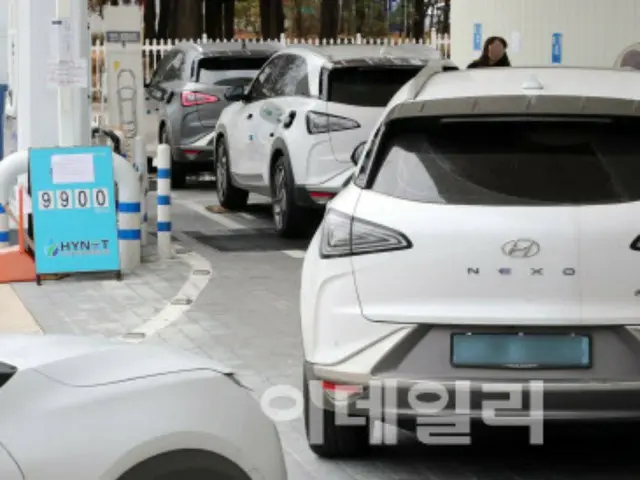There is chaos in the filling of hydrogen cars. The South Korean government is working with the industry to quickly create countermeasures, including the supply of alternative products, but filling hydrogen vehicles is expected to be halted for the time being.
An equipment failure at one hydrogen production base has caused problems in refilling hydrogen vehicles throughout the Chubu region, including the Tokyo metropolitan area, and there are growing calls for a policy failure. eco
Despite the rapid spread of automobiles, hydrogen production and filling infrastructure has been neglected, and the hydrogen market has been slow to grow.
According to the South Korean government and related industries, starting from the 23rd, hydrogen filling stations in the central region will be closed from the usual 10:00 p.m. to 7:00 p.m.
We have started to operate with shorter working hours, such as moving up the hours to other times. As a result, drivers of hydrogen cars have to wait in line for several hours to fill up with hydrogen.
Problems have occurred with two of the three hydrogen supply facilities at Hyundai Steel's Dan Jin Steel Works, and there are also problems with the inventory at the hydrogen filling station that receives hydrogen.
A problem is arising. Hyundai Steel produces approximately 3,500 tons of hydrogen for transportation annually, supplying 20% to 30% of the demand in the central region, including the Tokyo metropolitan area.
In response to the growing problem, the Ministry of Trade, Industry and Energy held a meeting to review the hydrogen supply and demand situation on the 24th, and decided to supply hydrogen.
The company requested cooperation from companies that operate hydrogen vehicle filling stations, as well as companies that operate hydrogen vehicle filling stations. From the 25th, the hydrogen filling station originally supplied by the Karatsu Steel Works in Yongin City, Gyeonggi Province, will be redirected to other hydrogen sources.
Substitutes supply from supply companies. However, problems are expected to continue this week due to inventory shortages at some hydrogen filling stations in the central region. Significantly increasing the supply of hydrogen for transportation nationwide in a short period of time
Even if alternative hydrogen is secured, it is considered difficult to completely compensate for the supply stoppage at production facilities. Hyundai Steel plans to complete repairs to the hydrogen production equipment at Karatsu Steel Works within this week.
However, as some parts will have to be imported, it will take more time for complete recovery. The South Korean government and industry have announced that hydrogen vehicles will remain dry until the hydrogen supply normalizes.
Bars are being urged to use hydrogen filling station information sites to search for filling stations that can supply hydrogen. The South Korean government has been criticized for its mismanagement in this situation. Hydrogen car driver
This is because they have complained from the beginning that there is a lack of charging infrastructure. In fact, according to the Hydrogen Economy Comprehensive Information Portal Site, the number of registered hydrogen vehicles across Korea has reached 33,796.
There are only 255 hydrogen filling stations. Poor hydrogen filling infrastructure is cited as a reason for the gradual decline in hydrogen car sales. Hydrogen production from the first quarter to the third quarter of this year
The number of motor vehicles sold was 4,013 units, a decrease of 47.3% compared to the same period last year. If this vicious cycle is repeated, there are concerns that the entire hydrogen industry, including production, distribution, and consumption, will shrink.
. The South Korean government's policies to revitalize the hydrogen economy are also retreating. The 2019 Hydrogen Economy Revitalization Roadmap aims to sell hydrogen vehicles such as 40,000 buses and 30,000 trucks by 2040.
The number of units will be 2.9 million, and hydrogen production and import supply plans will be developed accordingly. It has also been announced that the number of charging stations will increase to 1,200 during this period.
However, the hydrogen economy policy announced in November 2022 states that ``by 2030, 30,000 hydrogen buses and trucks will be used, and liquefied charging stations will be used.''
The target value was significantly reduced to 70 locations. It is said that the excessive quantitative growth goals have been realized in order to achieve qualitative growth, but no plans have been drawn up to popularize hydrogen vehicles and hydrogen filling stations.
Lee Ho-hyun, director of the Energy Policy Office of the Ministry of Industry, announced on the 26th that the hydrogen station at Incheon Airport Terminal 1 dedicated to hydrogen buses and the Yongin Ever, which is being supplied with alternative products, will be installed.
We visited a hydrogen station in the land and inspected the supply and demand situation. Director Lee said, ``The supply and demand situation is expected to gradually improve from this week,'' adding, ``In particular, the operation of buses, which are used by citizens, will be affected.
We will manage it so that it does not occur,'' he said.
2023/11/27 07:03 KST
Copyrights(C) Edaily wowkorea.jp 107

